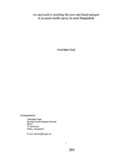An approach to reaching the poor and disadvantaged to promote health equity in rural Bangladesh
Date
2002Publisher
BRAC Research and Evaluation Division (RED)Author
Hadi, AbdullahelMetadata
Show full item recordCitation
Hadi, A. (2002). An approach to reaching the poor and disadvantaged to promote health equity in rural Bangladesh. Research Reports (2002): Health Studies, Vol - XXXII, 291–307.Abstract
Although the health care system has significantly expanded in the rural areas of Bangladesh duri!lg the .
last two decades, the overall health status of the population has remai~ed very poor because of the uneven
distribution of health and other basic services. The study asse~sed the contribution of micro credit-based
health interventions in reducing the differentials in the access to arid utilization of health services and
identified the specific interventions that might promote health equity.
Data for this study carne from the demographic and health surveillance system of BRAC covering
70 villages in I 0 regions of the country. The surveillance system provided updated sampling frame from
where a total of 3,208 households were selected at random for the survey. One adult woman from each
sampled household was selected for the interviews. The survey provided basic socioeconomic
information of the households, health status and access to health care and their participation in microcredit
program. In-depth interviews were also conducted with key informants such as community health
volunteers, local health care providers and the vulnerable individuals to assess the needs and availability
of the health care services for the poor. Data were collected in September 200 I.
Findings revealed significant socioeconomic differentials in the access to and the utilization of
health care in the study communities. Education and landownership were strong predictors of the health
service use. Gender differential in health care wa,s not significant. The access to and use of health care
were much higher among the micro-credit program participants than non-participants. The health care for
the poor should not only be subsidized but the mode of services must be appropriate to reach them.
Subsidized treatment and medicines for the extreme poor, targeted and appropriate health services, and
closer monitoring of the performance of health service providers was identified as prioritized
interventions for the poor.
Health services promotion at the grassroots level was costly when it was one-dimensional
program. The credit-based health promotion was cost-effective since other components such as income
generating activities, adult literacy and basic curative services were added to the package. The study
concludes that expanded health services, integrated with poverty-focus development program, can
significantly improve the access to and the utilization of health services among the poor in developing
countries.

